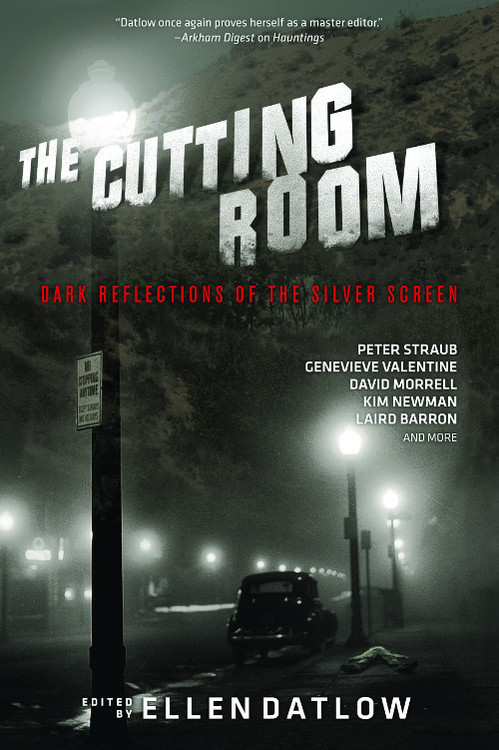THE CUTTING ROOM coming attraction: “The Hanged Man of Oz” by Steve Nagy

Over the next two weeks, in celebration of Halloween and the new anthology The Cutting Room: Dark Reflections of the Silver Screen, Tachyon and editor Ellen Datlow present excerpts from a selection of the volume’s horrifying tales.
Today’s selection comes from “The Hanged Man of Oz” by Steve Nagy.
Knee-high grass dominated the scene, thick blades uprooting the foundation of a sagging cabin, pushing aside cobbles in the shaded road. Trees circled the clearing and an abandoned orchard lay behind the cabin, straight rows masked by weeds and windrows of dead leaves and forgotten fruit.
A pastoral display except for the people posed throughout—two middle-aged men, one dressed as a hobo, the second clad in a dirty threadbare uniform; an old woman sporting too much rouge and mascara, skinny legs visible beneath the hem of a little girl’s dress; and a dead man, hanging from a tree, his feet twitching at odd moments in time with some unheralded tune raised by the wind whistling through the forest.
Obsession is an art form.
And if you’re lucky it’s contagious.
Denise and I got together for dinner and drinks at her place. Our first date, although we saw each other in the apartment hall every day. I lived in 2B. She had moved into 2C in February. I’d made great strides, starting with an occasional nod and shared rides to work. I’d eventually thrown out an off-the-cuff comment about her hair, which she’d shorn from its ponytail length to a flapper-style skullcap. Guys should notice changes like that; it’s an easy way to score points.
After that first compliment, the progression from casual to intimate was natural. We left in the morning at the same time, talked about our days, compared notes on work. If you practice something enough, anything is possible. I knew the boy-next-door routine better than when to observe national holidays. And the Fourth of July doesn’t change from year to year.
Besides dinner and drinks, Denise made me sit down and watch The Wizard of Oz.
“You’ve seen this before, Michael?”
“Lots of times,” I said. “Not lately, though. Isn’t it usually on around Easter?”
“Until recently,” Denise said. “Ted Turner bought the rights and pulled it for theatrical release.”
Oz? God save me. I already regretted the date and struggled to keep an interested expression as Denise gave me the inside scoop. It was like a psychotic version of Entertainment Tonight.
When I was in college I worked at a greasy spoon as a busboy. The chef was a compact Italian named Ricky Silva who came across as uneducated, unhealthy, and gullible. I stayed late one night, and I found Silva pouring over a stamp collection in a back booth. I questioned him about it, saying something crass because the idea of Silva as a philatelist didn’t match my preconceptions. He told me there were an infinite number of worlds. Each existed next to the other, always overlapping and occasionally intertwining. Learning about his deeper reality forced me to change my opinion of him.
Denise and Oz were like that. The places she went and the things she did contained wholly unexpected layers. Up until now I’d only seen her “hallway” face.
But I wasn’t in Kansas anymore.
The trivia litany went like this:
Buddy Ebsen—the original Tin Man—almost died from pneumonia, suffering a bad reaction to aluminum dust from his makeup, which let Jack Haley jump into his metal shoes.
The Cowardly Lion’s costume was so hot Bert Lahr passed out at least a dozen times.
The Munchkins raised so much holy hell on the set that Chevy Chase mined that aspect for Under the Rainbow.
Shirley Temple led the pack for Dorothy’s role. Probably because everyone considered Judy Garland too old and a poor box-office draw. The movie lost money, costing about $4.6 million and earning only $4 million the first time out.
Studio executives cut a groundbreaking dance number that showcased Ray Bolger. They believed audiences wouldn’t sit through a “children’s movie” if it was too long.
Faulty special effects burned Margaret Hamilton at the end of her first scene as the Wicked Witch. This was shortly after Garland arrived in Oz. Hamilton tried grabbing the ruby slippers, but was thwarted by the Good Witch, an actress named Billie Burke. Hamilton dropped below the stage and right into a badly timed burst of smoke and flame… .
It went on and on and on, everything you never wanted to know. Peccadilloes, idiosyncrasies; in other words, crap.
Then Denise told me a story about the man who hanged himself during filming—and she claimed the final print showed the incident.
“What? You’re kidding me. I’ve never seen a dead guy.”
Denise licked her lips, imitating a poorly belled cat. “Not everybody does. It’s like those 3-D pictures where you cross your eyes.”
“Prove it.”
Denise paused the video. On screen, Dorothy and the Scarecrow were in the midst of tricking the trees into giving up their apples, frozen seconds before stumbling across the Tin Man.
“It’s at the end of this section. I’ll run it through once at regular speed. Let me know if you catch it.”
She hit PLAY. Dorothy and the Scarecrow freed the Tin Man, did a little song-and-dance, fought off the Wicked Witch, and continued their trek. I didn’t see anything strange and shrugged when Denise paused it.
“Nothing, right?” She rewound the tape to a point immediately after the witch disappeared in a cloud of red-orange smoke (this time minus the hungry flames), then advanced the video frame by frame.
Our date had progressed from strange to surreal, and I couldn’t wait for an excuse to leave.
Then I saw him—the hanged man.
For information on The Cutting Room: Dark Reflections of the Silver Screen, visit the Tachyon page.
Cover by Josh Beatman.
